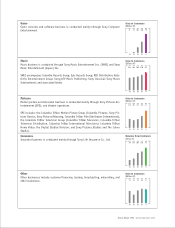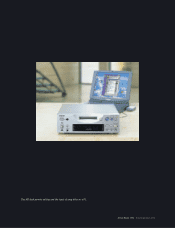Sony 1998 Annual Report Download - page 24
Download and view the complete annual report
Please find page 24 of the 1998 Sony annual report below. You can navigate through the pages in the report by either clicking on the pages listed below, or by using the keyword search tool below to find specific information within the annual report.[22] Sony Corporation Annual Report 1998
competitors by offering higher picture quality and larger screen sizes. This strategy contrib-
uted to another year of higher sales in the United States, mainly for large-screen models. In
Japan, Sony introduced Wega Screen high-resolution LCD projection TVs. These models incor-
porate a MUSE decoder for viewing of Hi-Vision broadcasts on 43-inch and 50-inch screens
with ease.
The market for professional-use projectors for PC presentations is expanding. During the
year, Sony introduced a model in Japan and overseas markets that has an extremely bright image
thanks to the use of a device developed by Texas Instruments Incorporated.
« Information and communications »
Personal Computers
Sony has built on the September 1996 introduction of VAIO home-use PCs in the United States
by adding original functions and designs. These innovations have offered new ways of enjoying
audiovisual equipment and PCs to a wide range of customers. In Japan, the VAIO mini-tower PC
and the VAIO notebook PC were launched in July 1997. The mini-tower PC makes it easy to
create video CDs and utilize digital photos and still images captured from digital video. A new
ultra-slim VAIO notebook PC was an enormous hit when it came on the market in Japan in
November 1997. This model features an outer case made of a magnesium alloy that is both light
and attractive. This sleek exterior complements the computer’s advanced functions, which in-
clude automatic collection of e-mail. Sony plans to introduce this series in the United States in
the summer of 1998. In March 1998, another member of the VAIO PCs made its debut in Japan:
the VAIO Compo PC, which enables music editing from products such as an MD deck that can
connect to a PC.
Computer Displays and Peripherals
In the computer display field, Sony is meeting the rising demand for larger screens and higher
picture quality. Adding more value to displays is another theme. In May 1998, Sony was first in
the world to begin selling a 21-inch computer display with a flat-surface CRT named FD Trinitron.
In computer peripherals, Sony brought to market a succession of new CD-ROM and CD-R
drives that can support higher signal processing speeds. In tandem with the growth in hard disk
capacity and the spread of servers, demand climbed for tape drives used for data backup. As a
next-generation data storage system, Sony and Fuji Photo Film Co., Ltd. jointly developed a
high-capacity 200MB floppy disk system called HiFD that is backward-compatible with existing
3.5-inch floppy disks; this product is scheduled to go on sale in the second half of 1998.
Digital Cellular Phones
During the year, sales of Sony’s digital cellular phones grew sharply in tandem with enlargement
of the market worldwide. In the United States, expansion of the CDMA (Code Division Multiple
Access) service area sparked an increase in monthly production of these phones to 400,000 units
at the joint venture of Sony and QUALCOMM Incorporated. In Japan, new PDC (Personal Digital
Cellular) handsets, which are compact, light and incorporate Jog Dial control, posted strong
sales. Good sales results were also recorded in Europe by ultra-compact GSM (Global System for
Mobile Communications) handsets, which also feature Jog Dial control.
Digital Broadcast Reception Systems
With an eye on the rapid proliferation of networks, Sony is moving aggressively into the field of
household information and communications terminals, including digital satellite broadcast recep-
tion systems. During the year, sales were again brisk for reception systems for CANAL+ digital
satellite broadcasts in Europe. In Japan, Sony began marketing new products for SKY PerfecTV!
digital satellite broadcasts in April 1998. SKY PerfecTV! is expected to launch an official pay
service in July 1998. Also, looking toward the digitization of cable TV in the United States, Sony
announced a plan in January 1998 to form a strategic alliance with NextLevel Systems Inc. of the
United States (now called General Instrument Corp.), to jointly develop digital TV technologies.
























